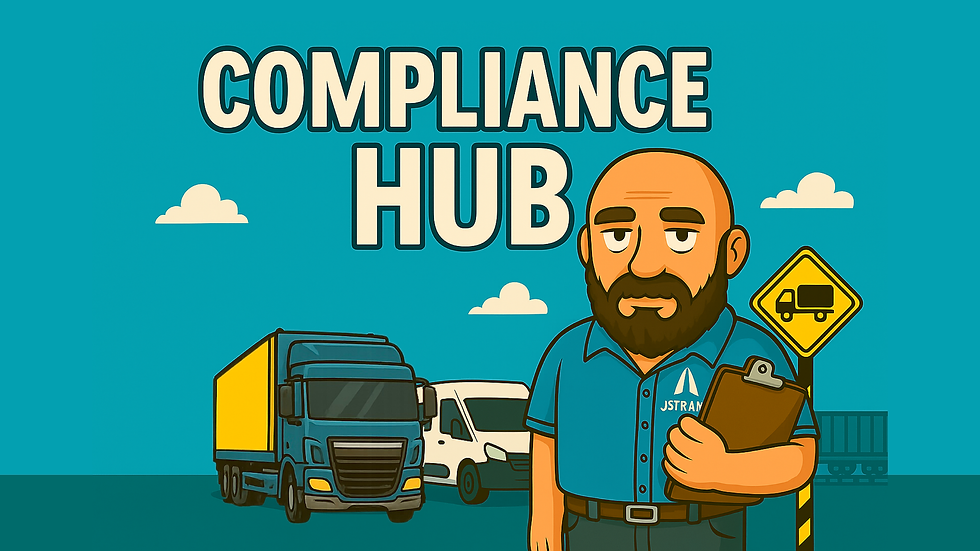100km Radius Rule: What You Need to Know for Exemption Claims
- stuart47304
- Jul 8
- 4 min read

The 100km radius rule is one of the most commonly misunderstood — and misused — aspects of tachograph law. Many small businesses believe they’re automatically exempt from tachograph requirements just because they stay within 100km of their base.
But in reality, the 100km exemption only applies under specific conditions — and misapplying it could leave you facing penalties or enforcement action from DVSA or the
Traffic Commissioner.
This guide explains everything you need to know about the 100km rule:
What the exemption is
Who qualifies
Common misconceptions
How to prove your exemption
What to do if your operation sometimes falls inside and outside the rules
What Is the 100km Radius Exemption?
The 100km exemption comes from EU Regulation 561/2006, which governs driver hours and tachograph use.
It says that some vehicles are exempt from tachograph use if they meet all of the following conditions:
The vehicle has a maximum authorised mass (MAM) not exceeding 7.5 tonnes
It is used within a 100km radius of its base
The vehicle is used by the driver to carry materials, equipment, or machinery for the driver’s own use in the course of their work
Driving is not the driver’s main activity
✅ This is often referred to as the “craftsman’s exemption” — aimed at builders, electricians, engineers, etc.
Who Can Use the 100km Exemption?
To qualify, you must tick all the boxes. Let’s break that down:
✅ 1. Vehicle Weight: Under 7.5t MAM
Includes most 3.5t vans and smaller 7.5t rigid lorries
Excludes larger HGVs, artics, and vehicle/trailer combinations over 7.5t
✅ 2. Operating Radius: 100km from Base
That’s 62 miles “as the crow flies”
Measured in a straight line — not road mileage
Applies from the base (operating centre), not where you start your journey
Tip: Use Google Maps “measure distance” tool to verify your radius.
✅ 3. Purpose: Carrying Equipment for Own Use
You must be transporting your own tools or materials
For your own work (e.g., building, repairs, installations)
Not delivering goods to customers
✅ 4. Main Activity: Not Professional Driving
Driving must be secondary to your main job
If you're hired to drive or spend most of your day on the road, the exemption does not apply
Who Is NOT Exempt Under the 100km Rule?
Scenario | Exempt? |
Builder driving a 7.5t truck 40km to site with tools | ✅ Yes |
Courier delivering customer parcels locally | ❌ No |
Florist delivering their own arrangements within town | ❌ No (main activity = driving/delivery) |
Farm contractor using tractor within 60km | ✅ Possibly under separate exemption |
Hire company delivering equipment to clients | ❌ No (carrying goods for others) |
Engineer driving a van with tools to site within 90km | ✅ Yes |
Common Myths About the 100km Rule
❌ Myth | ✅ Reality |
“If I stay under 100km, I don’t need a tacho.” | Only true if all other exemption criteria are also met. |
“It’s based on road mileage.” | No — it's a straight-line radius from base. |
“If I’m self-employed, I’m automatically exempt.” | The law applies to the vehicle and usage, not your employment status. |
“If I only drive a few hours, I’m exempt.” | Driving duration doesn’t matter — it’s about purpose, weight, and radius. |
How to Prove You’re Operating Under the 100km Exemption
If you rely on this exemption, be prepared to prove it at any time.
Here’s what you should keep on file:
🔹 Vehicle and driver records
Vehicle MAM clearly shown
Proof of base address
Driver’s job description or contract
🔹 Journey logs
Origin and destination of journeys
Purpose of each trip
Evidence you stayed within 100km radius (maps, delivery/job sheets)
🔹 Equipment carried
Tools lists or equipment manifests
Photos of vehicle load if needed
✅ Keep a logbook or exemption declaration in the cab, especially for drivers.
What If You Sometimes Qualify and Sometimes Don’t?
Many businesses switch between being exempt and non-exempt depending on the job.
Example:
Monday: Drive tools to site 45km away — ✅ exempt
Wednesday: Deliver equipment to a customer 120km away — ❌ not exempt
✅ What to do:
Use the tachograph and driver card on non-exempt days
Keep clear records of exempt days (manual log or declaration)
Maintain consistency in how you apply and explain your exemption
What If You’re Caught Misusing the Exemption?
DVSA treats misuse of exemptions very seriously. You could face:
Fines up to £300 per offence
Driver and operator prohibition notices
Public Inquiry and potential loss of Operator Licence
Investigation for fraudulent use of driver cards or non-use of tacho equipment
🚨 Restricted licence holders are not immune. You’re still subject to full enforcement.
Top Tips to Stay Compliant with the 100km Rule
✅ | Tip |
🔲 | Confirm your vehicle’s MAM is under 7.5t |
🔲 | Measure the 100km radius from your base |
🔲 | Use a driver activity log for exempt days |
🔲 | Keep journey records showing job purpose |
🔲 | Don’t assume — check each trip individually |
🔲 | Train staff to understand when exemption applies |
🔲 | Be ready to switch to tacho use as needed |
Conclusion
The 100km exemption is useful — but only if applied correctly. It’s designed for tradespeople and others whose driving is secondary to their main job. If you’re making deliveries, transporting goods for others, or leaving the radius — you’re not exempt and must use a tachograph.
By keeping clear records and assessing each journey honestly, you can stay compliant, avoid DVSA trouble, and protect your business.
